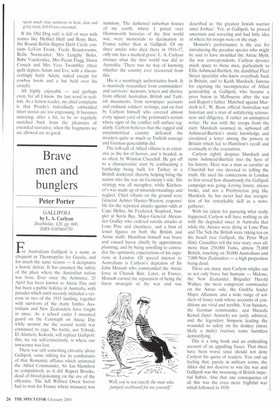Brave men and bunglers
Peter Porter
GALLIPOLI by L. A. Carlyon Doubleday, £20, pp. 600, ISBN 0385604750
or Australians Gallipoli is a name as eloquent as Thermopylae for Greeks, and for much the same reason — it designates a heroic defeat. It has assumed the rubric of the place where the Australian nation was born. Ever since the Armistice, 25 April has been known as Anzac Day and has been a public holiday in Australia, with parades which until recently included a veteran or two of the 1915 landing, together with survivors of the many battles Australians and New Zealanders have fought in since. As a school cadet I mounted guard on the Cenotaph on Anzac Day while around me the second world war continued to rage. No battle, not Tobruk. El Alamein, Kokoda, will replace Gallipoli: this, we say self-consciously, is where our innocence was lost.
There was still something chivalric about Gallipoli, some inkling for its combatants of that Romantic afflatus which animated the Allied Commander, Sir Ian Hamilton as compulsively as it did Rupert Brooke, dead of blood-poisoning on the eve of the offensive. The full Wilfred Owen horror had to wait for France where massacre was statutory. The darkened suburban houses of my youth, where I pored over Harmsworth histories of the first world war, were memorials to decimation in France rather than at Gallipoli. Of my three uncles who died there in 1916-17, only one has a marked grave. L. A. Carlyon stresses what the first world war did to Australia: 'There was no way of knowing whether the country ever recovered from this.'
His is a numbingly authoritative book. It is massively researched from commanders' and survivors' memoirs, letters and diaries; from official Australian, British and Turkish documents; from newspaper accounts and ordinary soldiers' writings; and on foot by Carlyon himself who covered almost every square yard of the peninsula's terrain where signs of the conflict still surface regularly. Carlyon believes that the ragged and unsymmetrical country defeated the invaders quite as much as Turkish courage and German generalship did.
The roll-call of Allied villains is as extensive as the list of heroes, and is headed, as so often, by Winston Churchill. He got off to a characteristic start by confiscating a battleship being built for Turkey in a British dockyard, thereby helping bring the nation into the war on Germany's side. His strategy was all metaphor, while Kitchener's was made up of misunderstandings and neglect. Chief villains on the ground were General Aylmer Hunter-Weston, responsible for the repeated attacks against odds at Cape Helies, Sir Frederick Stopford, bungler at Suvla Bay, Major-General Alexander Godley who ordered suicide attacks at Lone Pine and elsewhere, and a host of lesser figures on both the British and Anzac staffs, Hamilton himself was brave and caused havoc chiefly by approximate planning, and by being unwilling to contradict the optimistic expectations of his superiors in London. Of special interest to Australians is Canyon's depiction of Sir John Monash who commanded the Anzac force at Chenuk Bair. Later, in France, Monash earned the reputation of being the finest strategist of the war and was described as 'the greatest Jewish warrior since Joshua'. Yet, at Gallipoli, he proved uncertain and wavering and had little idea of where his troops were on the map.
Monash's performance is the cue for introducing the peculiar species who might be said to have moulded the Anzac Myth, the war correspondents. Carlyon devotes much space to these men, particularly to Ellis Ashmead-Bartlett, the dandified Fleet Street specialist who knew everybody back in Britain, and to Keith Murdoch, famous for exposing the incompetence of Allied generalship at Gallipoli, who became a press baron in Melbourne after the war and Rupert's father. Matched against Murdoch is C. W. Bean, official Australian war historian and a man of unfaltering seriousness and diligence, if rather an uninspired writer. He was with the troops from the start: Murdoch swanned in, siphoned off Ashmead-Bartlett's inside knowledge and circulated a letter among the powers in Britain which led to Hamilton's recall and eventually to the evacuation.
Carlyon rightly despises Murdoch and turns Ash mead-Bartlett into the hero of his history. Here was a man as cavalier as Churchill but one devoted to telling the truth. He used his connections in London to first reveal how disastrously the Gallipoli campaign was going. Loving luxury, always broke, and not a Presbyterian prig like Murdoch, he has never had due recognition of his remarkable skill as a newsgatherer.
With his talent for pursuing what really happened, Carlyon will have nothing to do with the degraded sneer in Australia that while the Anzacs were dying at Lone Pine and The Nek the British were taking tea on the beach (see Gallipoli, the Peter Weir film). Casualties tell the true story: over all, more than 250,000 Turks, almost 75,000 British, touching on 30,000 Australians and 7,000 New Zealanders — a high proportion being dead.
There are many men Carlyon singles out as not only brave but humane — Malone, the New Zealander, Brigadier Harold Walker, the most competent commander on the Anzac side, the Gurkha leader Major Allanson, and a wide range of soldiers of lesser rank whose accounts of conditions are vivid and terrible. Von Sanders, the German commander. and Mustafa Kemal (later Ataturk) are justly admired, and the legendary Simpson leading the wounded to safety on his donkey (more likely a mule) receives some harmless demystifying.
This is a long book and an enthralling account of an appalling fiasco. That there have been worse since should not deny Carlyon his quota of readers. You end up feeling that, purely in military terms, the Allies did not deserve to win the war and Gallipoli was the swansong of British imperial hubris. Also that one consequence of all this was the even more frightful war which followed in 1939.


















































 Previous page
Previous page